The Rise of a Hybrid Future.
The global pandemic has reshaped our relationship with how and why and where we work. For many organizations it is now clear that the workplaces we left behind are never coming back. Those were places where we unquestioningly arrived each day. Places where we labored over tasks that could have been performed just about anywhere, and where we wasted our energy and our time being present for no reason other than to be counted – as opposed to the value we bring to the people around us.
Presence, of course, is still an incredibly important part of our work experience. Our proximity to others is one way in which we influence behavior, shared beliefs, and team culture. It is critical to the way we learn, and the relationships we build. But it is not an end into itself, and it should never be without intention.
If we believe in the importance of our shared experiences, or as psychologists call it – our sense of Propinquity, we must envision an entirely new approach to work. One that supports us at home, in the office, and everywhere in between. And we must strive to understand both our behavioral and psychological needs as much as we understand the requirements of the tasks we perform.
Some call this new workplace, “Hybrid”, or “Flex” work. Whatever we call it, we must recognize that at its core – this new workplace experience is one which must bring new meaning to our work and our relationships. The office must become a destination worth coming to. A place that serves an entirely new and a far more meaningful purpose than ever before. It exists to bring us together, to connect us to a greater sense of purpose, to generate shared connections and relationships, and to support work or tasks that are better when performed togethe
New Work Styles
In creating this new Hybrid workplace we must understand and define the work styles that exist within it. We must also understand that each of us has a unique relationship to how, and why, and where we work best. There is no one-size fits all solution for creating a more personal and meaningful work experience. Instead, each of us stands along a point on a spectrum which shifts and moves based on our needs, our behavioral traits, and a variety of both internal and external influences.
To help us identify these work styles and the behavioral traits behind them, the team at +One conducted a study which began with a behavioral assessment within our own parent organization, One Workplace. That work then shifted to an open survey of workers and organizational leaders across North America. The result was the development of a workstyle predictor tool which gives us new insight into the Hybrid work future.
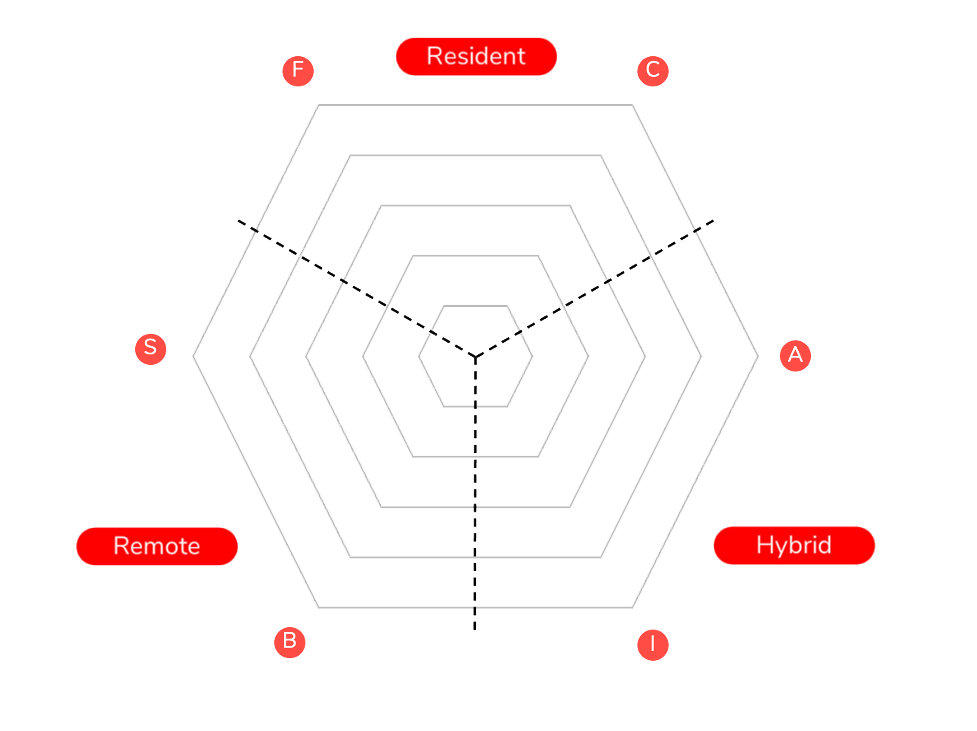
Six Behavioral Traits for Hybrid Work Models
It is likely unsurprising that the three distinct work styles identified here fall into the categories of Remote, Hybrid, and Resident, something we will talk more about later. What is worth knowing instead is why individuals are better suited for one specific work style over another. Knowing the behavioral traits associated with each work style preference allows us the ability to design initiatives, programs, protocols, practices, rituals, and workspaces that support these very diverse needs.
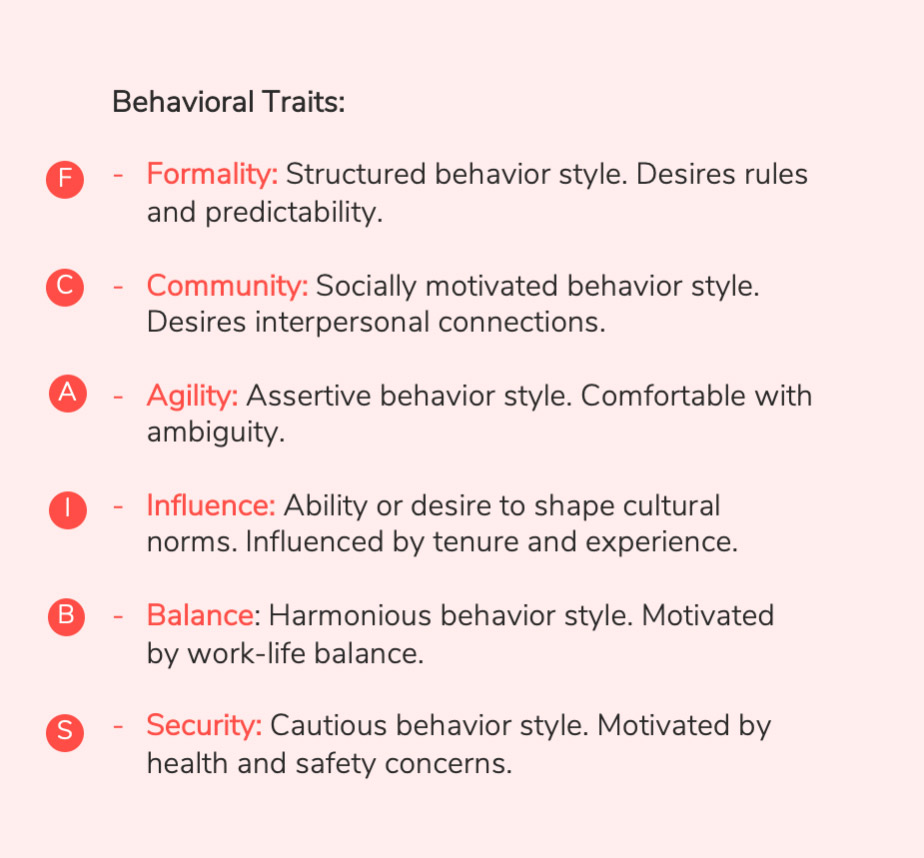
Formality
Workers with a strong sense of formality require a greater sense of certainty in their work and their work experience. They want control of their work and their work setting. They prefer defined processes and procedures and wish to minimize the risk of the unknown.
Community
Workers with a strong sense of community require frequent and more meaningful social interactions. This group of workers are more likely to feel a sense of strain and disconnection from remote work. They are energized by their relationships to others and seek bonds to the people they work with.
Agility
Workers with a strong sense of agility are flexible, adaptable, and highly assertive. Their dominant behavior style makes them adept at working whenever and wherever. They can move quickly between different settings or situations and can sometimes get bored with routine.
Influence
Workers with a strong sense of influence have a deep passion for their work and their work life. They want to actively shape the culture of their organization or are interested in being shaped by it. These team members seek out opportunities to put their thumb print on everything they touch.
Balance:
Workers who seek balance often have a desire to manage many commitments both in their personal and professional lives. Families, friends, hobbies, passions, vocations, and careers each carry an important weight and deserve specific attention and care.
Security:
Workers with a strong desire for security are distinctly concerned about the health, safety and welfare of themselves, their family, and those around them. In this time of COVID-19, these may be team members with concerns about transmission of the virus, or just require greater control over their own health matters.
Pattern Logic

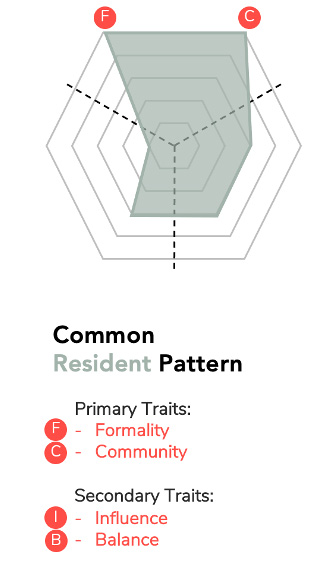

Resident:
A Resident work style preference is typically driven by two factors: Formality and Community.
Residents generally prefer consistency within their work experience and work best when provided an individually owned workspace. Residents often desire a strong personal connection to the people and experiences that happen within the workplace.
Hybrid:
A Hybrid workstyle preference is typically driven by two factors: Agility and Influence. Hybrid workers want to have more control over their work experience and are comfortable flowing through many different work locations and work modes. Hybrid workers desire a strong connection to workplace culture but are willing to accept the tradeoff between the ability to influence the organization, and the increased flexibility in shaping their own work experience.
Remote:
Remote workers generally desire greater work-life balance and often have personal commitments or other factors that make working from the office prohibitive or difficult. Remote workers may also have specific health and safety concerns related to the COVID-19 pandemic that makes working from home preferable.
What We Learned
While this study is still active – early results have indicated several clear learnings.
Hybrid is King:
52% of respondents align to a Hybrid work experience, while 35% are likely best suited to a remote work style. Only 13% of respondents matched to an owned desk experience.
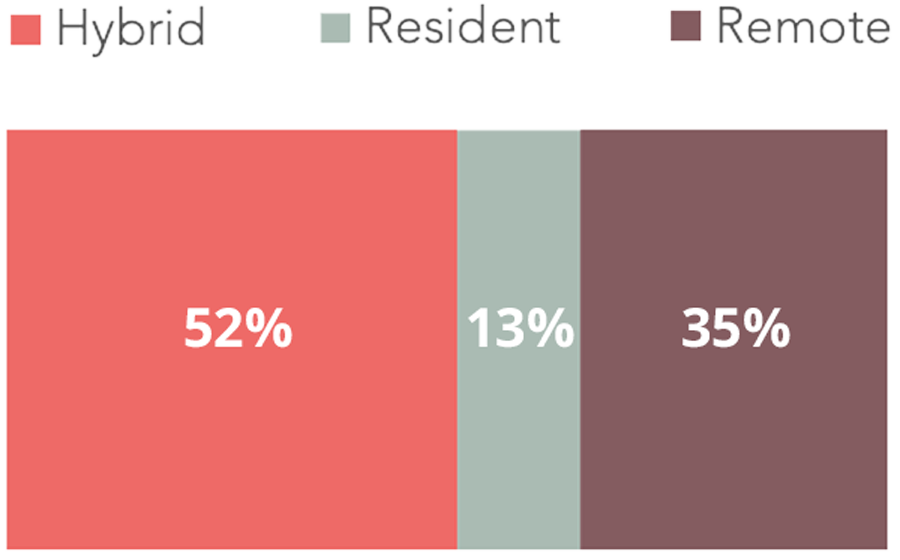
Primary Vs. Secondary Work Style Preferences & Why the Office Still Matters:
60% of survey responses included a strong secondary preference for an alternate work style. The most common secondary preference was for a Resident work mode. The most significant factors at play in these instances include the ability to participate within an organization’s sense of community and to influence or be influenced by others. This learning prompts us to believe that the office of the future may be shaped less by the individual desk experience and more by its ability to create shared interpersonal connections.
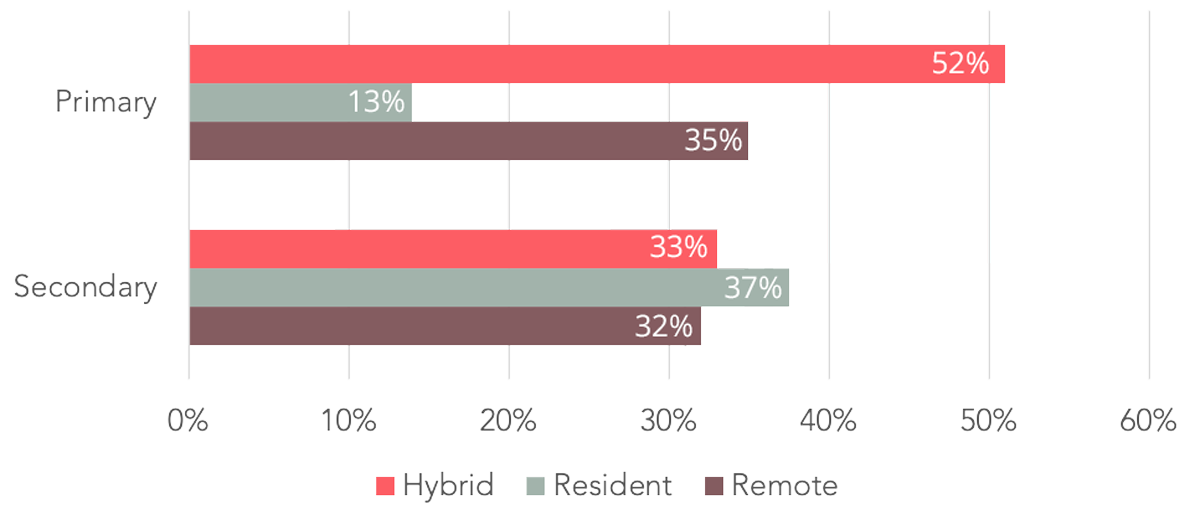
Work Life Balance is Here to Stay – and Influence is More Important Than Ever.
The single largest factor at play in shaping work style preferences is the desire for work-life balance. This was true regardless of whichever work style was prevalent. The second highest factor was Influence: our desire to shape or be shaped by the culture of our organization.
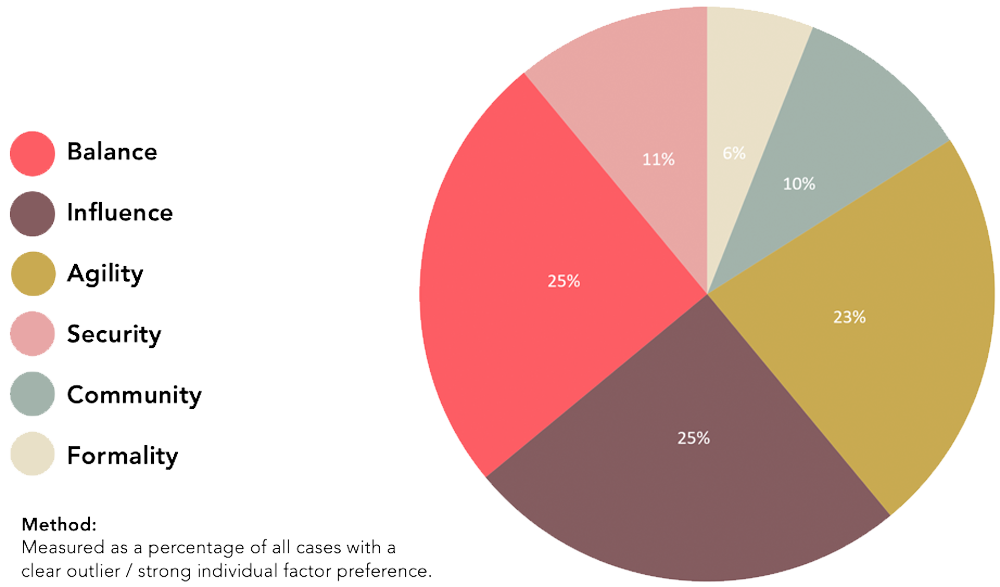
A Place to Belong – The New Mission of the Hybrid Workplace
These learnings teach us that the future of work will occur in many settings and in many places. And that among those places, the physical office or workplace still matters. But for an entirely new reason. The office no longer exists as a place for tasks but rather as a place for belonging.
There is little benefit in returning to the office in order to perform tasks which we are better able to be performed at home or somewhere else. Commuting to an office is not an effective work strategy for the sole purpose of answering e-mails, or taking an on-line training, or to be on a video call with team members in an entirely different location.
The pandemic has uncovered the fact that much of our work is perfectly well suited – or maybe even better suited, to be performed at home or other third places. We have also learned that there is much more to our work experience that can’t be replicated sitting by ourselves, alone in a room, behind a zoom screen. These are the elements of our work that help us feel a part of something bigger than ourselves. The moments that allow us to make intimate connections with our peers or our customers. Those experiences happen best when we share space together in the office – and they are more important than ever.
According to a recent McKinsey study, one of the leading reasons that people are leaving jobs or the workforce has nothing to do with compensation or work-life balance, but instead it is determined by whether someone feels a sense of social belonging at work. The hybrid workplace is not as much about supporting the tasks of work as it is with fostering the social bonds that tie us to each other, our customers, our mission, and our community. Whether we are residents, hybrid workers, or remote workers we have to be intentional about creating these moments of connection for ourselves and for our teams, both physically and virtually.
Places for Belonging
This approach assumes that our offices exist for something more meaningful than an individual work. But not at its complete exclusion of course. The workplace will always require places to support individual tasks. This is due to the fact that each of our workdays are varied and complex. We are far more likely to jump from meeting to task to customer engagement – than we are to sit in one place all day. To reflect this, our workplaces need to support a wide variety of settings and functions. We will always need a quiet place to think and to read an e-mail – but that work is not reason alone for why we should come to the office.
In this hybrid future we will come to the office to engage and be engaged – and that is a new way of thinking about our workplaces, why they exist, what they should offer, and why we might go there.
- ”If we think people are going to return to the office just to perform the same tasks that they can do from home, we are wrong.“
- “Our teams are much more likely to come if they believe they will find a stronger connection to our shared sense of community and purpose.”
Creating Places for Belonging
Creating a successful hybrid workplace is a shared responsibility. It requires support, buy-in, and resources from each of us as individuals, as well as from every level of the organization. Leadership must invest in workplaces and programs to provide effective settings and support or gathering, connecting, and delivering our work. Managers must shift their focus to shaping the social experience of each of their team members, and each of us must now make our decision to come to the office with greater planning and intentionality – ensuring that we are choosing to be in the office on days where our opportunities for connection are strongest.
4 Steps for Creating Belonging within the Workplace
- Design office settings designed to support a wide array of work modes from collaboration, to focus, play, socialization, respite, and wellness, etc…
- Implement and support org-wide employee experience and cultural connection programs designed for specifically for the needs of residents, remote, and hybrid workers.
- Train and prepare managers to provide them the tools for creating physical and virtual engagements with their teams and their customers.
- Reset expectations for how, where, when and why we come to a physical office.
Wherever you are in your hybrid work journey, we encourage you to learn more about the motivators and behavior profiles of your employees. Recognize that the old way of working and relating to our workplaces is long dead and consider, that the new mission and purpose of your offices is instead to serve as the cultural center of your organization. The places where your values and your beliefs are collectively expressed, lived, and shared with your team. Your people are looking for a place to belong – let’s provide it to them regardless of whichever work style suits them best.
About the Author:
Christopher Good is Chief Creative Officer at One Workplace, and Co-Founder of +One Work Culture Consulting. His work is dedicated to changing the way we think about our relationship to work and the workplace. He is an advocate of the design thinking process and is a frequent speaker and presenter at events across the country, leading active workshops to solve big problems. Most of all he believes in the power of design to do good things for other people.